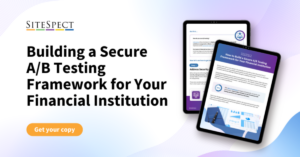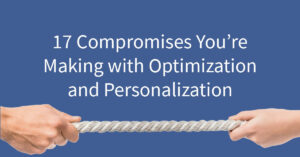Part 3/6: What Experience Should You Show A User
By Justin Bougher
March 12, 2020
Share
Welcome back to my blog series, “5 Questions You Need to Answer to Optimize an Experience.” If you missed the first two, you can find them here, “Five Questions You Need to Answer to Optimize an Experience,” and here, “Who is the User.” In this blog, I’m tackling Question Two: What experience should you show a user?
The experience you show a user depends on how much information you were able to gather about them when you answered the question, Who is the User? With that information, you can map each user to the right experience. Let’s look at some of the nuances of assigning experiences to different users.
Align User Experience with Marketing
A big part of delivering the right user experience at the right time is matching your site or app to your marketing campaigns. If a user has seen emails, social media posts, targeted ads, or printed advertising, they are in a marketing segment. Outbound marketing groups can have anywhere from 5 to 100 different user segments each requiring a different user experience. The question then becomes, Do you know which ad they saw, and can you map them to a consistent experience now?
If the user is coming directly from an online ad, social media post, or an email, capturing aspects of the referral URL and parameters is a quick way to make sure you can map them to the right experience moving forward. For example, say you work for a shoe retailer, and you are running several campaigns. One features athletic shoes, another formal shoes, and a third sandals. Each of these ads will contain a link to your website homepage, however, each link will feature different parameters. For example, you might be working with the following appending parameters:
- ?utm_source=ig&utm_medium=social&utm_campaign=athletic
- ?utm_source=ig&utm_medium=social&utm_campaign=formal
- ?utm_source=ig&utm_medium=social&utm_campaign=sandals
All of these links refer to the homepage of www.example.com. However, based on these links, with an A/B testing or personalization tool (like SiteSpect) you can create a different experience — essentially three different homepages.
Note that this works not just for marketing. You may have user segments that live in other parts of your organization. If your ecosystem offers a data layer that dictates a user’s segment and appropriate experience, you need to respond to that direction and have the direct mapping setup between predetermined segments and their corresponding experience.
Rules for Your Algorithms to Provide the Right Experience
When implementing targeting or personalization, you may use rules or algorithms. Rules are broader, for example: If a user comes from Facebook, give them experience A. Algorithms are dynamic, and adjust to target each individual. For example, perhaps you have different combinations of featured items that could appear on your homepage. An algorithm would be able to adjust for instances like:
- User A clicked on an ad for formal shoes, and in the past she has bought athletic shoes. Her homepage may feature formal shoes in the hero image, but also simplified navigation, or size comparisons to athletic shoes.
- User B clicked on an ad for sandals, and is a first-time visitor. He may see sandals featured in his hero image, and see a first order discount offer.
Addressing every micro-audience with the desired experience with a “set it and forget it” algorithm can be captivating. With smart algorithms in place, you can automate a lot of the work behind answering the question, What experience should I show the user?
When using these types of auto-optimization techniques it’s important to pay attention to a few details. First, make sure that certain combinations of images and copy that don’t make sense are off limits. (Ex. User A shouldn’t see a first order discount and a “Welcome Back” message). After that, it’s important to know what happens when a user jumps from one segment to another. If a user has been offered a promotion and then does something in session that makes you believe they actually should have been in a different promotion, you want to control the transition between those promotions. Often the best time to switch that experience is in the next session, not the current one.
1-1 Personalization Isn’t Out of Reach
Finally, when we’re discussing what experience to best show each user, we have to address the trend of 1-1 personalization. This term has been used a lot recently and it’s good to understand what it really means. Creating all the images and copy for a given experience takes a lot of effort. Creating a unique version of a hero image for a landing page for every user, for example, is usually not where you are going to get the best return on your investment to drive conversion. So 1-1 personalization does not mean creating truly individual experiences for each user.
Instead, for 1-1 personalization, typically we are talking about combining personalized product recommendations with a targeted segment for images and copy. In other words, it’s more about dynamically combining your available content to suit the user in the moment. The user first gets mapped to the correct segment — usually algorithmically — and any products shown throughout the customer journey are personalized. This gets you the unique 1-1 experience without spending too much time and effort on the diminishing returns of creating images and copy.
To learn more about SiteSpect, visit our website.
Share
Suggested Posts
Subscribe to our blog:





